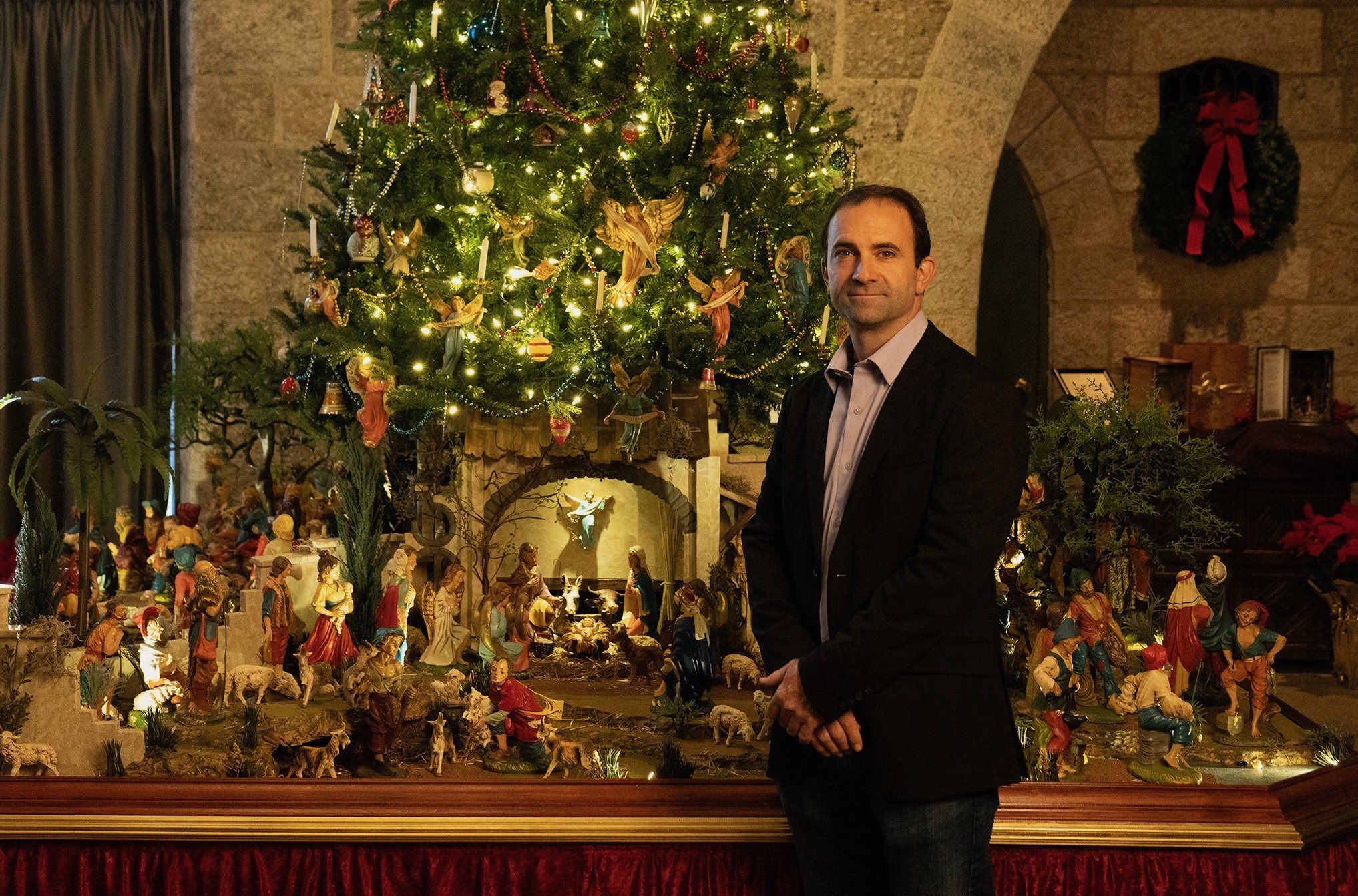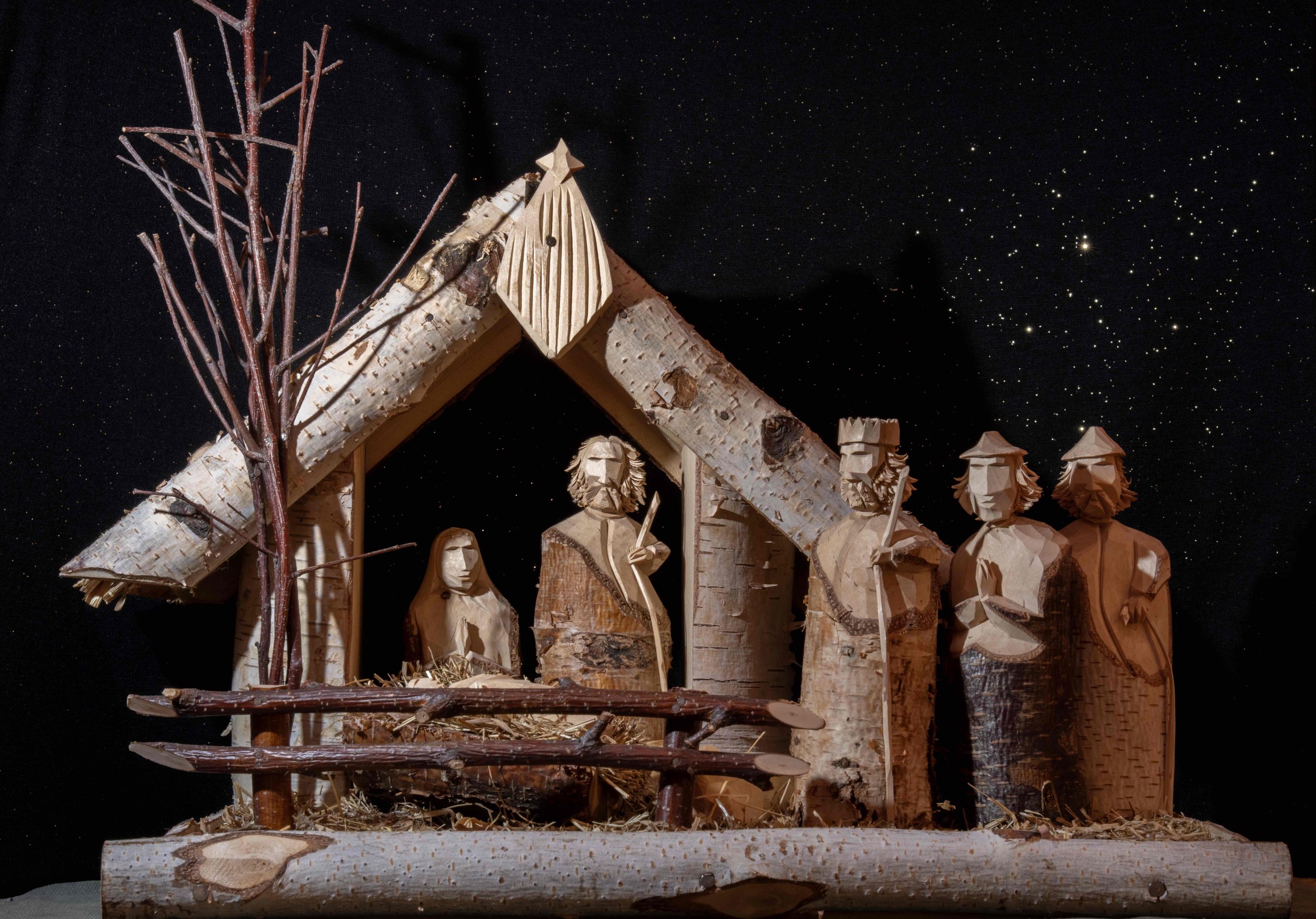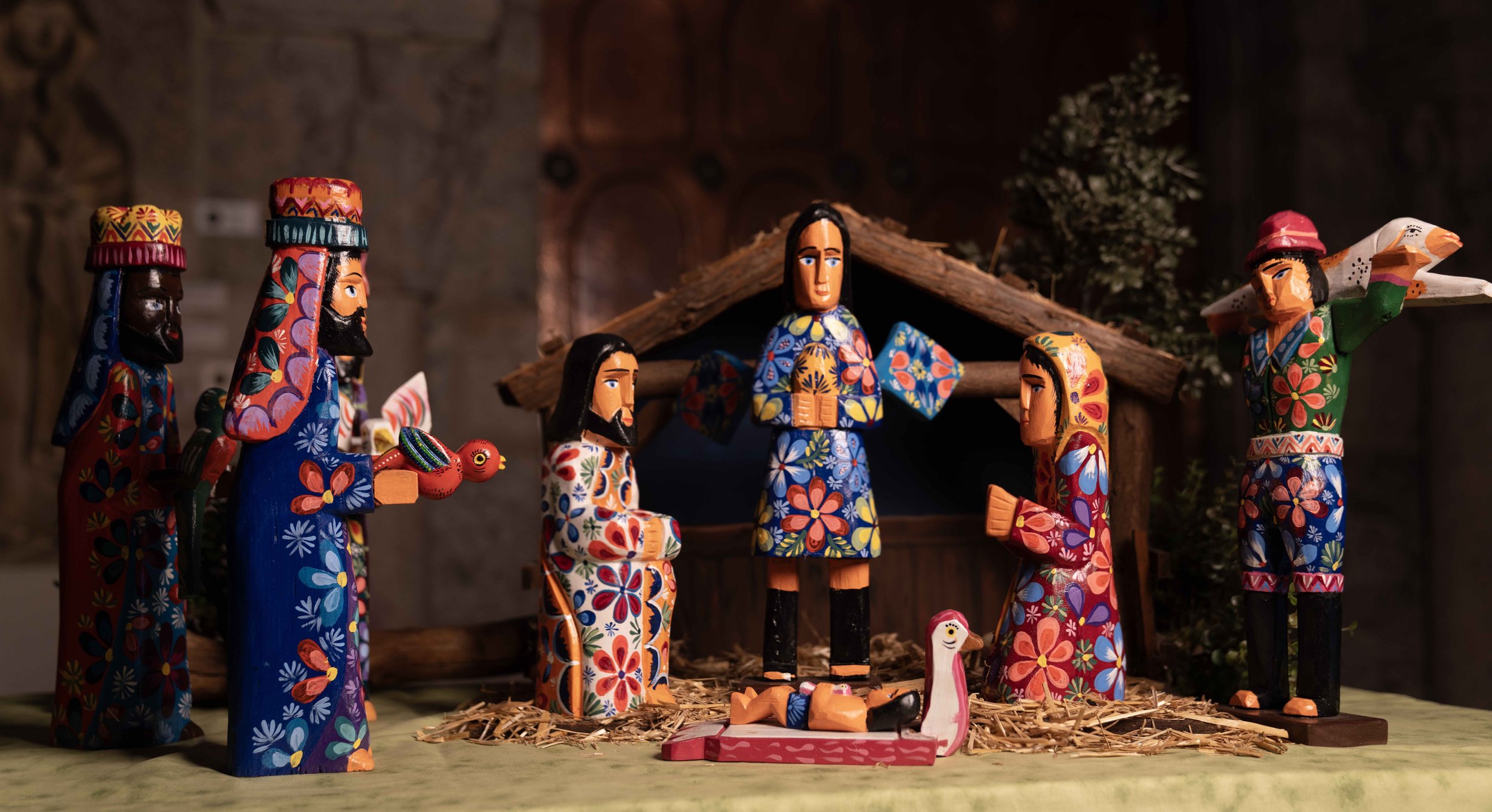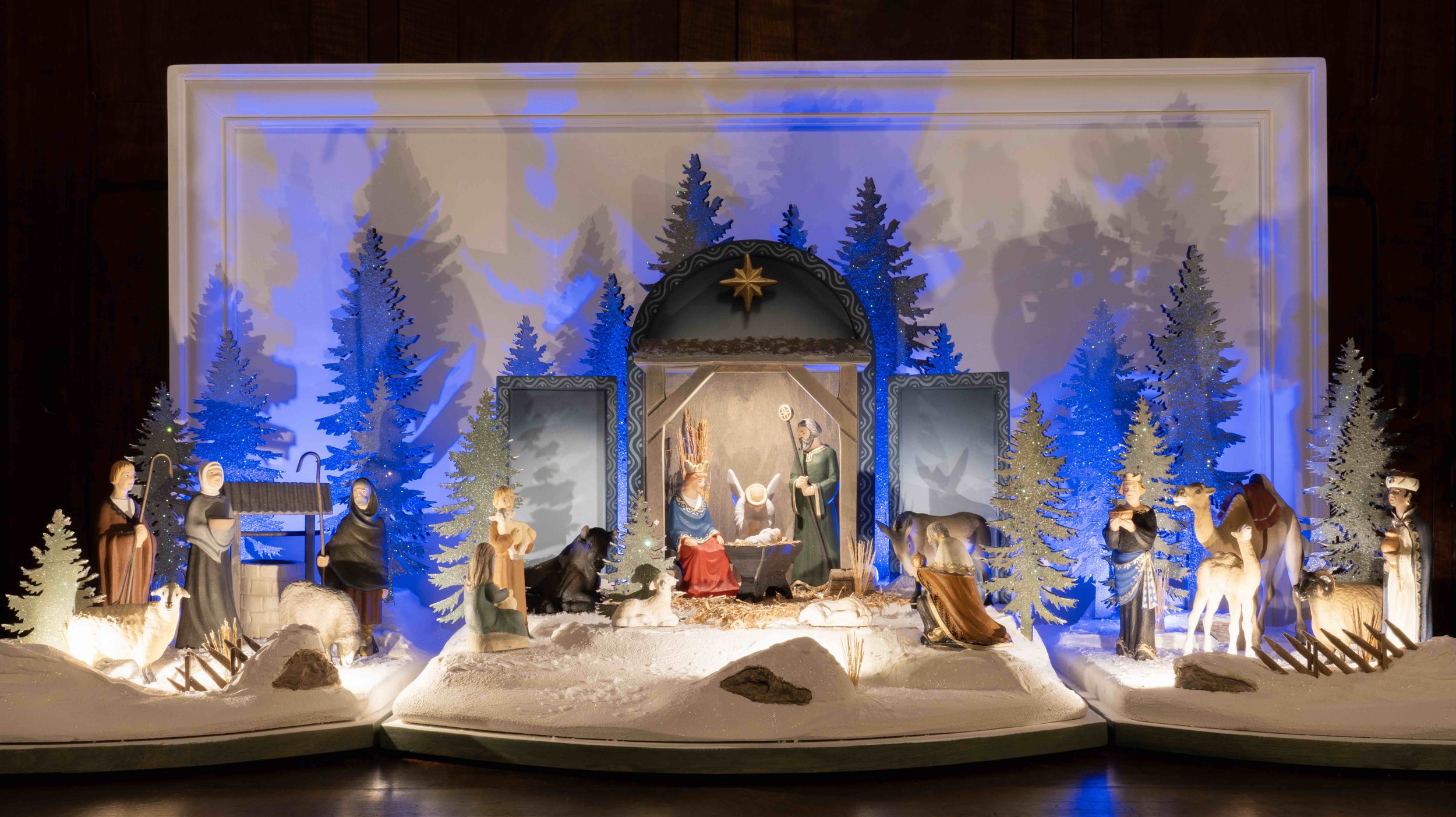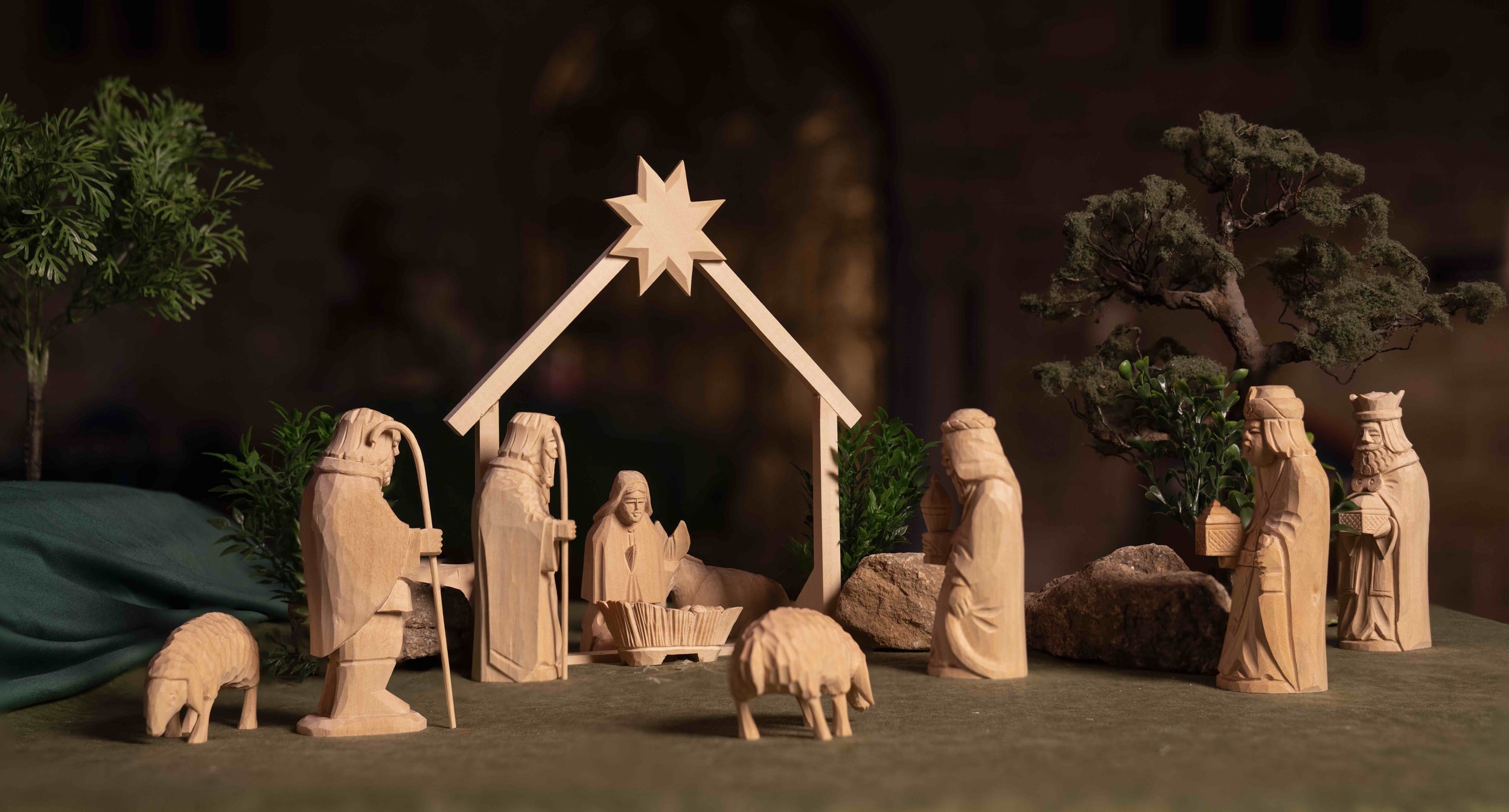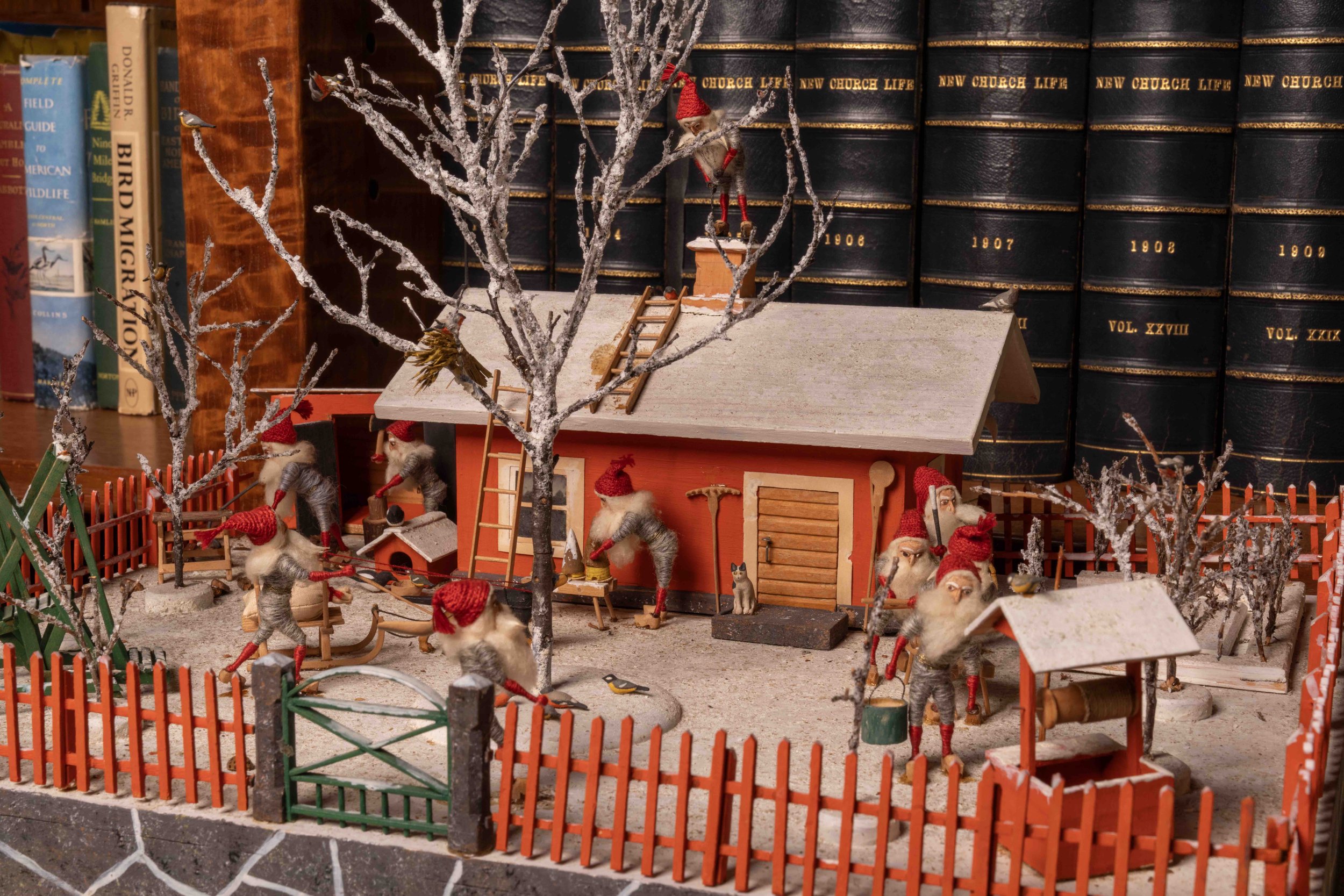Glencairn Museum News | Number 12, 2023
New Jersey artists Karen Loccisano and R. Michael Palan, a husband-and-wife team, handcrafted this Nativity scene between 2014 and 2023. Their inspiration was a 16th-century painting by Flemish artist Pieter Brueghel depicting Mary and Joseph in a snowy Flemish village. On loan from Karen Loccisano and R. Michael Palan, Bridgewater, New Jersey.
The Nativity scene, depicting Jesus Christ’s birth in Bethlehem, is an important symbol for many Christians worldwide. Nativity scenes usually combine several different accounts from the Bible detailing Christ’s birth. While most Nativities include both the Magi, or wise men, and the shepherds, the story of the Magi is told only in the Gospel of Matthew, while the story of the shepherds is told only in the Gospel of Luke. Artists sometimes expand the scene with additional imagery, drawing from early Christian texts—such as the ox and donkey from the Gospel of Pseudo-Matthew—or their own creative imaginations. A small selection of the Nativities in this year’s World Nativities exhibition follows below (Figures 1-16), along with several objects featured in this year’s Christmas in the Castle tour (Figures 17–19).
Figure 1: Detail of a Nativity scene made by Karen Loccisano and R. Michael Palan, inspired by a 16th-century painting by Flemish artist Pieter Brueghel (see also lead photo, above). Palan focused on making the architectural elements, furniture, and many intricate details, including hidden features like a framed structure beneath the thatched roof of the barn. Loccisano sculpted and attired the human figures and created the animals. In 2023, one of their Nativities (American Nativity) was accepted in Presepi in Vaticano, an exhibition at the Vatican under the Colonnade of St. Peter’s Square. On loan from Karen Loccisano and R. Michael Palan, Bridgewater, New Jersey.
Figure 2: Created in 2023 for Glencairn Museum’s World Nativities exhibition, The Grand Cartapesta Presepe draws inspiration from the iconic “Angel Tree” and the Neapolitan Nativity scene at the Metropolitan Museum of Art in New York City. The installation, made by A.J. DiAntonio of Navidad Nativities in Bucks County, PA, features his personal collection of paper mache Nativity figures made by the Italian companies Fontanini and Euromarchi (1930s–1960s). For more information and an interview with DiAntonio, see Glencairn Museum News 11, 2023: “The Grand Cartapesta Presepe: A Collector’s Vision.” On loan from A.J. DiAntonio, Malvern, PA.
Figure 3: Poland has a rich tradition of wood carving. This Nativity, hand carved from birch wood, shows the wise men visiting the Holy Family at the stable in Bethlehem. The birch bark has been left on the lower parts of all the figures, except for the baby Jesus, giving each one an individual color and tone.
Figure 4: This Nativity from Guatemala includes the Christ Child in a manger shaped like a rooster, holding what appears to be a toy in the shape of a rooster. This could symbolically refer to the Misa de Gallo (Mass of the Rooster), a Christmas Eve Midnight Mass observed in Guatemala.
Figure 5: An artist working for the Presbyterian Handicraft Center in the Republic of Cameroon (West Central Africa) created this 17-piece Nativity. The pieces were shaped from clay, fired, and dipped in a solution containing eucalyptus to give them a bronze-like appearance. The animals in this Nativity include a sheep, camels, and the distinctive local zebu cattle.
Figure 6: These Nativity figures and stable were carved in 1959 in the workshop of Hans and Adolf Heinzeller in Oberammergau, a village in the Bavarian Alps known for its woodcarving tradition. Hans (1896–1973) founded his woodcarving business in Oberammergau in 1945 and co-established a workshop with his son, Adolf, in 1949. Their woodcarvings can be found in collections worldwide. In 1965, they created a four-foot-tall Nativity set for Westminster Abbey, where it is still in use.
Figure 7: This Nativity set, inspired by medieval wooden sculpture, was crafted by Henning, a Norwegian woodcarving company established in 1947 by Henning Engelsen. The design and color choices reflect the local woodcarving tradition. The original setting was made by Navidad Nativities, Inc., of Bucks County, PA: “Inspired by Scandinavian simplicity and the enchantment of a Nordic winter’s night. Nestled in a forest of frosty Norway spruce trees among the shimmering drifted snow.” On loan from Navidad Nativities, Bucks County, PA.
Figure 8: Volodymyr Kravchenko and his family have been making Christian-themed woodcarvings for over 20 years. According to Kravchenko, “My family and I live in a small town in the Lviv region, in Ukraine. . . My favorite work is the Nativity scene, 11 figures in which, not only is work invested, but also a particle of the soul is invested. Especially in our time, when we have a lot of grief, tears, and sorrow in the country, when we have a war in the country, it is important that the carving gives joy, gives warmth. This is exactly what I hope our Nativity scene is like.” (April, 2022)
Figure 9: These Nativity figures, created in Egypt in ceramic workshops in the cities of Cairo and Akhmim, wear traditional clothing typical of Upper Egypt. Egypt holds significance in the biblical account of the Nativity, particularly in the Gospel of Matthew. According to Matthew, an angel appeared to Joseph in a dream, advising him to take his family to Egypt to escape persecution by King Herod.
Figure 10: Madagascar is the fourth-largest island globally, located off the southeastern coast of Africa. This Nativity was obtained directly from a carver at an open-air market in the capital city, Antananarivo, which is famous for its woodcarving workshops. Madagascar has a rich tradition of woodcarving with regional variations within the island. Notably, the “woodcrafting knowledge” of the Zafimaniry people received UNESCO recognition in 2008 as an Intangible Cultural Heritage of Humanity site.
Figure 11: Born in Jemez Pueblo, New Mexico, Alma Loretto Maestas began making pottery at the age of nine. She started crafting Nacimientos (Nativities) in the 1960s, several of which are now in the collection of the Smithsonian Institution. The Christ Child rests within a traditional cradleboard, and the angel’s mouth is open, in the tradition of the renowned Pueblo storyteller figures. The wise men hold gifts that reflect Pueblo culture: corn, bread, and chili peppers.
Figure 12: Judy Gibson King first became interested in the role that religious art plays in the expression of faith when she took a college art history course. King’s figures are known for their nontraditional presentation of traditional images. In her Nativity scene, it is Joseph, not Mary, who holds the baby Jesus. Mary lies asleep with her head in Joseph’s lap, while an angel peeks down at the Holy Family from above.
Figure 13: The figures and structures in this Presepio (Nativity scene) were collected over more than three decades by the late Elizabeth Anne Evans of Bucks County during her annual trips to Italy. The Presepio tradition, which has been called “the translation of the Bible into Neapolitan dialect,” represents daily life in 18th-century Naples, a bustling port city. The figures are clothed in period costumes typical of the aristocracy, peasants, and visiting foreigners. The Nativity miracle is depicted as taking place amid crumbling Roman ruins, signifying the end of the pagan world and the dawn of Christianity.
Figure 14: Michael Mezalick, of Mezalick Design Studio, LLC, designed and created this scene titled “No Room at the Inn” in 2023. Mezalick drew inspiration from the recent popularity of “book nooks” and the work of Navidad Nativities in Bucks County, PA. Each figure has been hand-painted, and the exterior cases for the scenes are crafted from wood, fabric, and other materials. On loan from Navidad Nativities, Bucks County, PA.
Figure 15: This 11-piece Nativity was carved by Thorsten Sigstedt. Sigstedt was born in Stockholm, Sweden, a country with a rich tradition of woodcarving. In the early 1920s, his talent received recognition when he won a Swedish national competition for the commission to carve decorations on the royal ceremonial boat, Vasaorden. In 1928, Sigstedt relocated to the United States and eventually established his residence in Bryn Athyn, Pennsylvania, where he maintained both his home and a studio.
Figure 16: In the 1920s, Bryn Athyn artist Winfred S. Hyatt crafted three Nativity scenes, one of which portrays the Magi observing the Star of Bethlehem. Raymond and Mildred Pitcairn commissioned these scenes for their home at Cairnwood, where they were the most important element in the Christmas decorations in the parlor hall. When the Pitcairn family moved to Glencairn in 1939, these scenes moved with them. They have been displayed in Glencairn’s Upper Hall ever since.
Figure 17: In the 1920s, the Raymond and Mildred Pitcairn family received this winter tomtelandskap (tomtar diorama) from a Swedish friend. Tomtar, local spirits rooted in pre-Christian Scandinavia, were believed to care for the household, farm, and livestock, but could be mischievous if offended. The scene features a red Swedish-style cottage, and tomtar engaged in various activities such as chimney-cleaning, beekeeping, pipe-smoking, and wood-chopping. A wheat sheaf is lodged in one of the trees, a traditional Swedish Christmas treat for the birds. This object is currently on the 2023 Christmas in the Castle tour.
Figure 18: Inspired in part by the 1923 Swedish tomtelandskap gifted to the Raymond and Mildred Pitcairn family (see Figure 17), the artists Karen Loccisano and R. Michael Palan created this collection of tomtar, gnomes, and other magical creatures from Scandinavian folklore. Nearly everything in this scene was handcrafted by the artists. Currently on the 2023 Christmas in the Castle tour; on loan from Karen Loccisano and R. Michael Palan, Bridgewater, New Jersey.
Figure 19: Over time, the mythology surrounding tomtar (see Figures 17–18) blended with other Scandinavian folklore traditions and figures such as Saint Nicholas and Santa Claus. Today, the Swedish name for Santa Claus is Jultomte, or simply Tomte. Currently on the 2023 Christmas in the Castle tour; on loan from Karen Loccisano and R. Michael Palan, Bridgewater, New Jersey.
(CEG)



